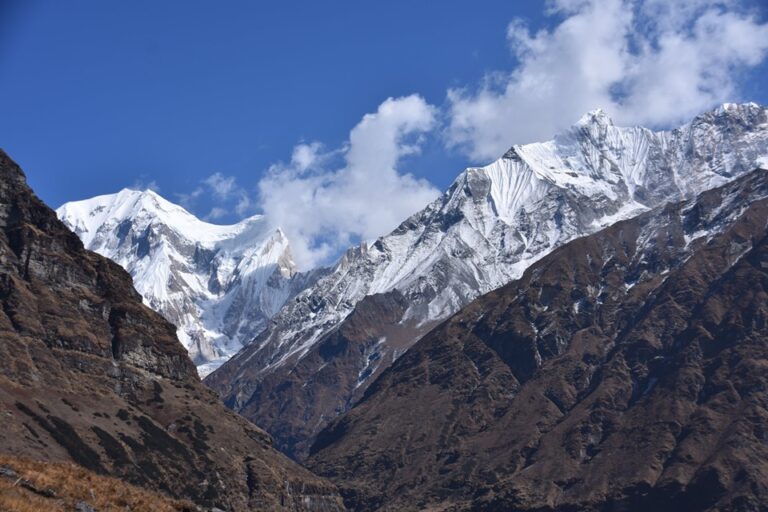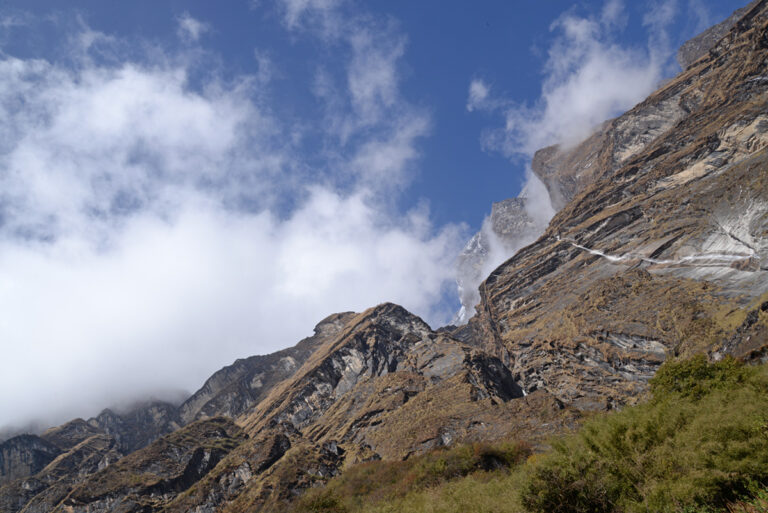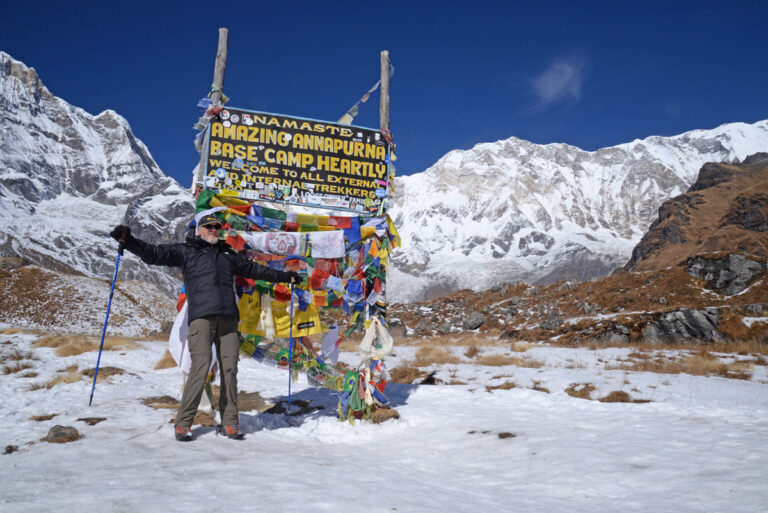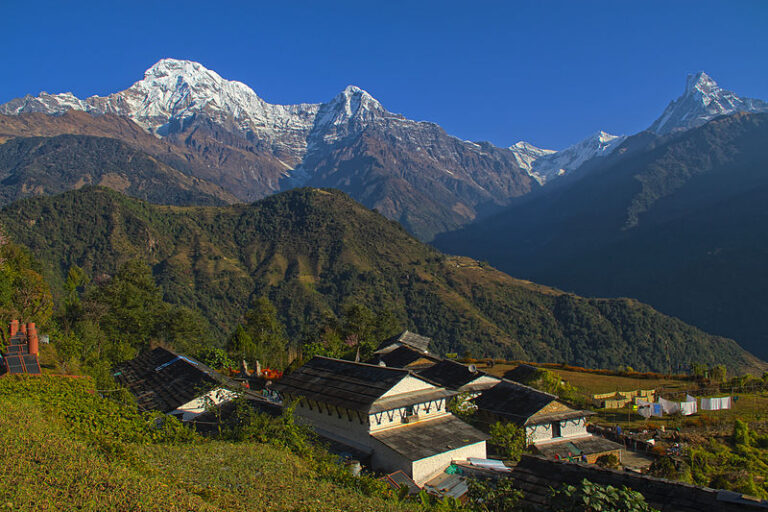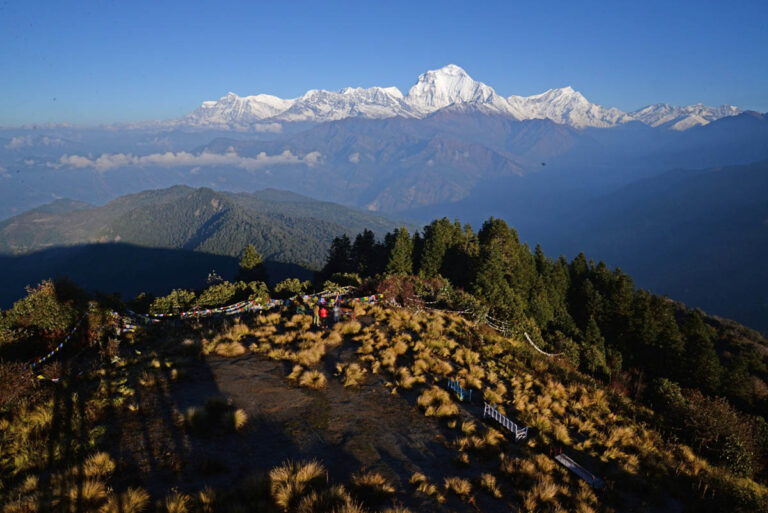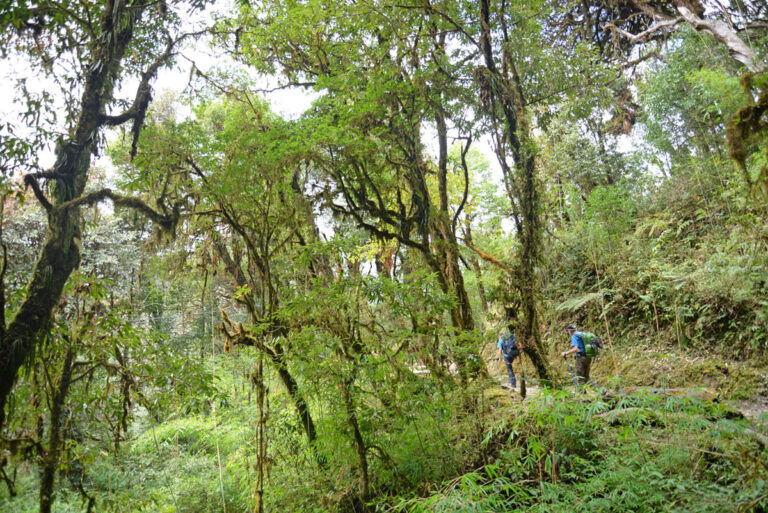Day 01 – we will pick you up from the Kathmandu airport on your arrival date and transfer to the hotel. Your hotel will be in the center of the Thamel, which is one of the tourist hubs in Kathmandu city.
Day 02 – Sight trip to the ancient and historical places in Kathmandu city, like Pashupatinath Hindu temple, the Baudhanath stupa, Durbar square, and Swayambhunath stupa which is also known as monkey temple due to moving hundreds of monkeys around the temple compound.
Day 03 – Drive to Pokhara (810m.a.s.l) – 6 to 7 hours drive – Pokhara is 204 kilometers far from the Kathmandu valley so we will drive an approximately 6 to 7 hours, will depend on our transportation. During the driving period, we will have a beautiful view of paddy terraced field, River valleys, dozens of small villages which are settled over the vertical land, and as well as far view of Manaslu, Ganesha Himal and Annapurna mountain ranges.
Day 04 – Drive to Nayapul and hike up to the Ulleri village (1960m.a.s.l) – 5 hours walk – we will drive about 1 hour until Nayapul which is 42 kilometers far from Pokhara then the trail leads us to Ulleri village beside the Bhurundi River with the view of vertical rice terraced field, charms green hills and through many small villages known as Ramghai, Sudame, Hile and Tikhedhunga. Trek from Nayapul to Tikhedhunga would be very pleasant due to walk on the flat and gradual trail. We will do a lunch break in the Hile village and after that, we will ascend 530 meters to get Ulleri village that offers to see a magnificent view of Annapurna south which is 7219 meters high.
Day 05 – Trek to Ghorepani (2860ma.s.l) – 6 hours walk – The morning offers us to see beautiful view of south Annapurna and charms landscape from our breakfast table. The trail ascends step by step through the rice terrace fields and passes by many guesthouses and teashops till Banthati village that takes about two hours. After the Banthati village, the trail will be mostly flat for one hour and it is possible to see some wildlife due to walk through the dense forest of rhododendrons. We will have our lunch in the Nangethati village and after that, we will climb continuously about two hours to get Ghorepani.
Day 06 – Hike up to Poon hill and trek to Tadapani (2630m.a.s.l) 5 hours walk – we have to wake up early in the morning to go Poon hill viewpoint that takes about 45 minutes. Poon hill purpose to see a beautiful sunrise and a spectacular view of Annapurna ranges like Annapurna 1, 2, 3, Fishtail, South Annapurna, Himchuli, Nilgiri, Dhaulagiri, the Thukuche peak and the Manaslu massif views. After the “early morning trek”, we will come back to the hotel for breakfast, before to trek until Tadapani. At the beginning of the trek, you have to climb up about 1:30 hours to a panoramic hilltop. After that, the trail will be mostly flat till the Deurali village where we’ll walk through a dense forest of bamboo, pines and rhododendrons. Crossed the Deurali village we will head down for 1 hour to the Banthati village, where we will stop for lunch before the trek continues up and downhill for 1:30 minutes to get Tadapani.
Day 07 – Trek to Chhomrong village (2170m.a.s.l) – 6 hours walk – also this morning we’ll have the opportunity to see the sunrise and the view of Fishtail, Himchuli and the south Annapurna from your breakfast table. After breakfast, we will descend 600 meters to the Komrong River through the dense forest of rhododendron and vertical terraced fields. We’ll cross the Komrong River by a suspension bridge and climb up about 30 minutes to Gurjung village where we will pick up our lunch and trek continuously to Chomrong for another 2:30 hours.
Day 08 – Trek to Dobhan (2660m.a.s.l) – 5 hours walk – The trail descends from the yard of the guesthouse to get a small stream then ascends to the Sinuwa village pass by a small village called Bhunuwa. Sinuwa is the perfect place to see Machhapuchhre Mountain due to locate the top of the hill. From Sinuwa; the trail leads us through the forested trail with the view of waterfalls, huge rocky hills, and vista of Machhapuchhre. We will have our lunch in Bamboo village then continuously trek to Dobhan that may take another one hour.
Day 09 – Trek to Deurali (3200m.a.s.l)– 5 hours walk – The pleasant path leads us to Deurali village through the lush bamboo and Rhododendron forest with chirp sound of birds and gurgled sound of the Modi River. Most of the time, we will ascend on a rocky path following by the River so major attraction of the trek would be the view of waterfalls, green forest, and huge rocky hills that are standing both sides. There are four guesthouses in Deurali village, provides narrow but cleanrooms for the trekkers and their trekking crews.
Day 10 – Trek to Annapurna base camp (4130m.a.s.l) – 5 hours walk – Today is one of the joyful day entire the trip because we will have a closer view of Machhapuchhre 6993m, Hiuchuli 6441m, Annapurna south 7219m, Gandharba chili 6248m, Tharpu peak 5695m, Singu Chuli 6501m, Baraha Shikhar 7647m and including a stunning view of Annapurna first which is 8091 meters high. Most of the time we will ascend through the silver birch and bamboo forest to get Machhapuchhre base camp then the tree line will end from Machhapuchhre base camp then we will walk another three hours on the gigantic pastureland to get Annapurna base camp.
Day 11 – Trek to Bamboo (2310m.a.s.l) – 7 hours walk – we will wake up early in the morning to see the sunrise views on the background of the White Mountains, especially the white Annapurna one change into the golden color. After breakfast, we will return back to Bamboo village via the same trail. We will descend about 1800 meters that might take about seven hours depend on our walking speed and condition of our knees.
Day 12 –Trek to Jhinu Danda (1780m.a.s.l) – 6 hours walk – we will follow the same trail until Chhomrong village because there isn’t any alternative trails get back from Annapurna base camp valley. Begins of the trek we will ascend for 45 minutes to get Khuldighar then the rest of the trek is pleasant and flat until Sinuwa village. We will do lunch break in Chhomrong village with a magnificent view of Annapurna south, Hiuchuli and Machhapuchhre mountains. From Chhomrong; the downhill trail leads us to Jhinu Danda which is also well known as a hot spring because there are small natural hot water sources near the Modi River. So after a long time spent in cold places, we can take a regenerating bath in the hot pools.
Day 13 – Trek to Tolka 1700 meter – 5 hours walk – There are two trails to get Pokhara from Jhinu Danda like via Landruk-Tolka- Pritam Deurali- Pothana-Australian cam and drive back to Pokhara from Kande village or trek via Kyumi- Siwai- Syauli Bazaar- Birethanti and drive back to Pokhara from Nayapul but still Australian camp will be worth a visit. We can reach this camp via Pritam Deurali – Pothana, adding to your experience in Nepal another memorable trekking day. From the Australian Camp you will enjoy a spectacular view of the Annapurna range, the Dhaulagiri range, and the massif of Manaslu.
Day 14 –Trek to Australian camp (1830m.a.s.l) – 5 hours walk – Tolka to Australian camp takes about 5 hours and the trail leads us through the forest with view on of south Annapurna, the Himchuli and the Mardi Himal. At the beginning of the trek, we will walk on a flat trail, passing by rice terraced fields and through the mixed forest of sandalwood, just in time to reach Pritam Deurali and then we need to climb up about 30 minutes on a mostly gradual up trail till the Australian camp.
Day 15 – Trek to Kande and drive back to Pokhara – The morning commands us to see the beautiful sunrise, superb mountains view and charm landscapes from the yard of the guesthouse. After taking some photographs, we will walk the downhill trail for two hours to get Kande village then drive back to Pokhara.
Day 16 – Drive or fly back to Kathmandu – There are two options to get back to Kathmandu from Pokhara. If trekkers want to drive a tourist bus then the bus leaves 7:30 AM from the tourist bus park and takes about 7 hours to get Kathmandu. The flight takes 25 minutes and offers to see massif view of Annapurna, Dhaulagiri, Langtang, Ganesha Himal and Manaslu mountain ranges from the window of the Plane.
Day 17 – Final Departure – after a successful trip of Annapurna base camp and great experience of Nepal you will fly back to your home with hundreds of tales about the jungle, mountains, culture, and memory of Nepal.
